Bosch GSS 23 AE Professional: English
English: Bosch GSS 23 AE Professional
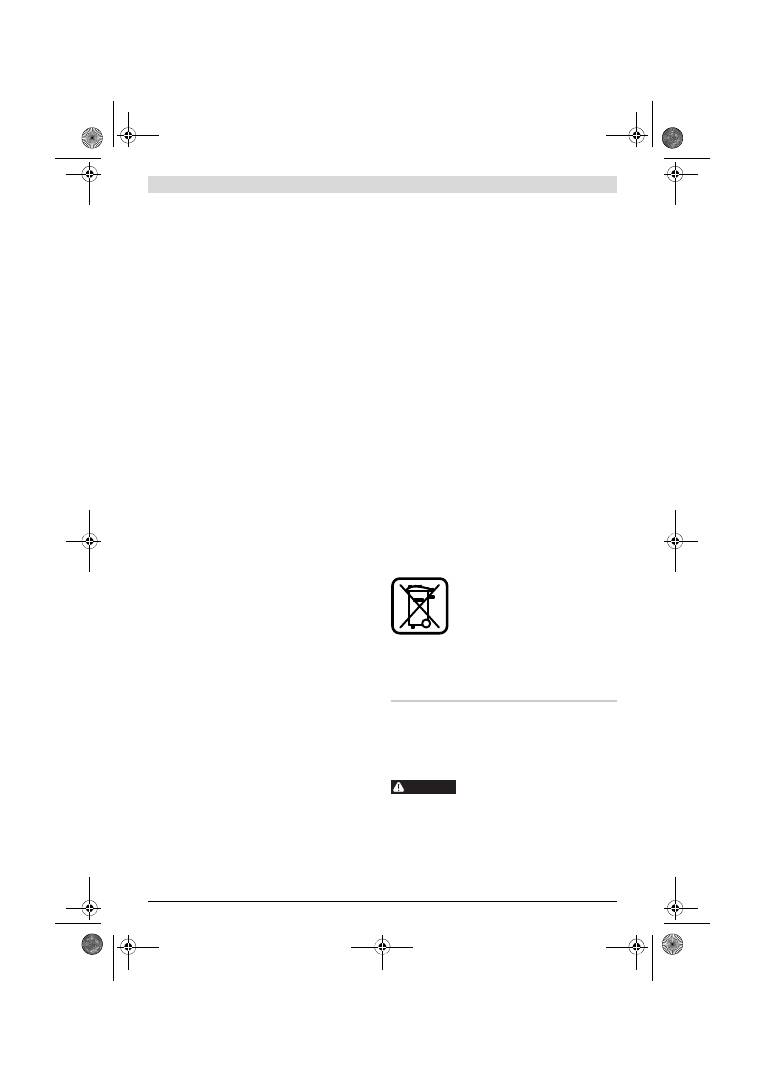
10
| English
2 609 141 028 | (30.1.13)
Bosch Power Tools
Die erforderliche Schwingzahl ist vom Werkstoff und den Ar-
beitsbedingungen abhängig und kann durch praktischen Ver-
such ermittelt werden.
Arbeitshinweise
Warten Sie, bis das Elektrowerkzeug zum Stillstand ge-
kommen ist, bevor Sie es ablegen.
Die Abtragsleistung beim Schleifen wird im Wesentlichen
durch die Wahl des Schleifblattes sowie durch die vorgewähl-
te Schwingzahl bestimmt.
Nur einwandfreie Schleifblätter bringen gute Schleifleistung
und schonen das Elektrowerkzeug.
Achten Sie auf gleichmäßigen Anpressdruck, um die Lebens-
dauer der Schleifblätter zu erhöhen.
Eine übermäßige Erhöhung des Anpressdruckes führt nicht zu
einer höheren Schleifleistung, sondern zu stärkerem Ver-
schleiß des Elektrowerkzeuges und des Schleifblattes.
Benutzen Sie ein Schleifblatt, mit dem Metall bearbeitet wur-
de, nicht mehr für andere Materialien.
Verwenden Sie nur original Bosch-Schleifzubehör.
Wartung und Service
Wartung und Reinigung
Ziehen Sie vor allen Arbeiten am Elektrowerkzeug den
Netzstecker aus der Steckdose.
Halten Sie das Elektrowerkzeug und die Lüftungs-
schlitze sauber, um gut und sicher zu arbeiten.
Wenn ein Ersatz der Anschlussleitung erforderlich ist, dann
ist dies von Bosch oder einer autorisierten Kundendienststel-
le für Bosch-Elektrowerkzeuge auszuführen, um Sicherheits-
gefährdungen zu vermeiden.
Sollte das Elektrowerkzeug trotz sorgfältiger Herstellungs-
und Prüfverfahren einmal ausfallen, ist die Reparatur von ei-
ner autorisierten Kundendienststelle für Bosch-Elektrowerk-
zeuge ausführen zu lassen.
Geben Sie bei allen Rückfragen und Ersatzteilbestellungen
bitte unbedingt die 10-stellige Sachnummer laut Typenschild
des Elektrowerkzeuges an.
Kundendienst und Anwendungsberatung
Der Kundendienst beantwortet Ihre Fragen zu Reparatur und
Wartung Ihres Produkts sowie zu Ersatzteilen. Explosions-
zeichnungen und Informationen zu Ersatzteilen finden Sie
auch unter:
www.bosch-pt.com
Das Bosch-Anwendungsberatungs-Team hilft Ihnen gerne bei
Fragen zu unseren Produkten und deren Zubehör.
www.powertool-portal.de
, das Internetportal für Handwer-
ker und Heimwerker.
Deutschland
Robert Bosch GmbH
Servicezentrum Elektrowerkzeuge
Zur Luhne 2
37589 Kalefeld – Willershausen
Unter www.bosch-pt.com können Sie online Ersatzteile be-
stellen oder Reparaturen anmelden.
Kundendienst: Tel.: (0711) 40040480
Fax: (0711) 40040481
E-Mail: Servicezentrum.Elektrowerkzeuge@de.bosch.com
Anwendungsberatung: Tel.: (0711) 40040480
Fax: (0711) 40040482
E-Mail: Anwendungsberatung.pt@de.bosch.com
Österreich
Tel.: (01) 797222010
Fax: (01) 797222011
E-Mail: service.elektrowerkzeuge@at.bosch.com
Schweiz
Tel.: (044) 8471511
Fax: (044) 8471551
E-Mail: Aftersales.Service@de.bosch.com
Luxemburg
Tel.: +32 2 588 0589
Fax: +32 2 588 0595
E-Mail: outillage.gereedschap@be.bosch.com
Entsorgung
Elektrowerkzeuge, Zubehör und Verpackungen sollen einer
umweltgerechten Wiederverwertung zugeführt werden.
Nur für EU-Länder:
Gemäß der Europäischen Richtlinie
2002/96/EG über Elektro- und Elektronik-
Altgeräte und ihrer Umsetzung in nationales
Recht müssen nicht mehr gebrauchsfähige
Elektrowerkzeuge getrennt gesammelt und
einer umweltgerechten Wiederverwertung
zugeführt werden.
Änderungen vorbehalten.
English
Safety Notes
General Power Tool Safety Warnings
Read all safety warnings and all in-
structions.
Failure to follow the warnings
and instructions may result in electric shock, fire and/or seri-
ous injury.
Save all warnings and instructions for future reference.
The term “power tool” in the warnings refers to your mains-
operated (corded) power tool or battery-operated (cordless)
power tool.
WARNING
OBJ_BUCH-80-003.book Page 10 Wednesday, January 30, 2013 9:13 AM
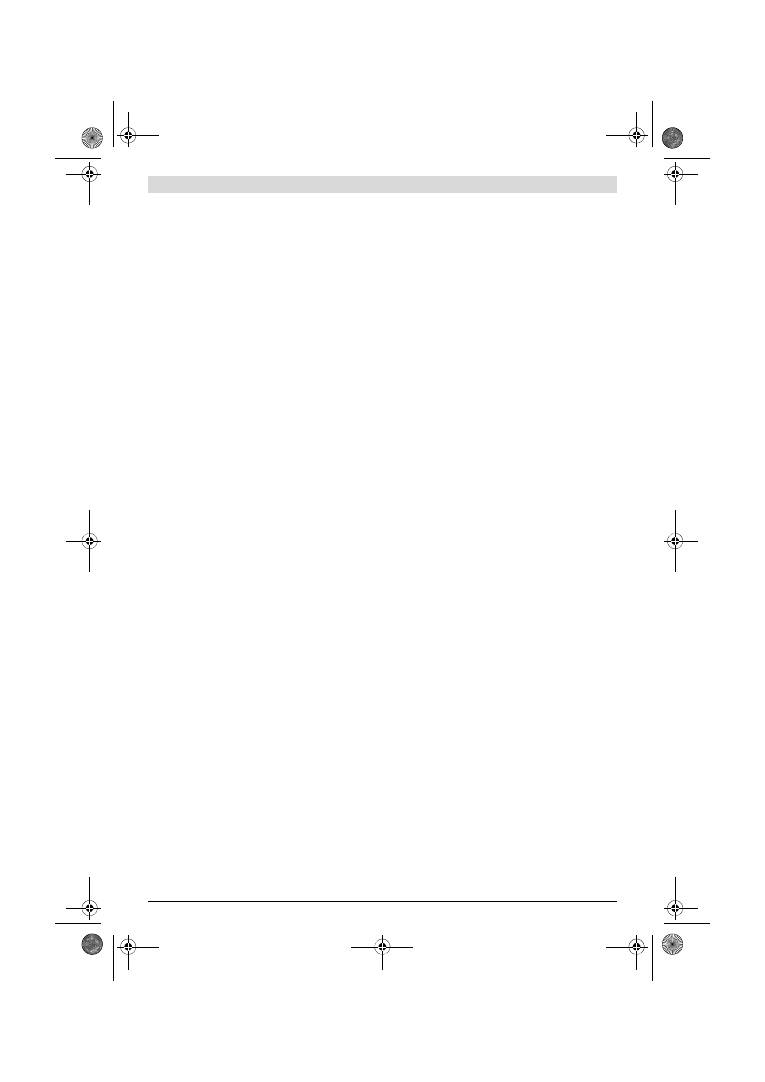
English |
11
Bosch Power Tools
2 609 141 028 | (30.1.13)
Work area safety
Keep work area clean and well lit.
Cluttered or dark areas
invite accidents.
Do not operate power tools in explosive atmospheres,
such as in the presence of flammable liquids, gases or
dust.
Power tools create sparks which may ignite the dust
or fumes.
Keep children and bystanders away while operating a
power tool.
Distractions can cause you to lose control.
Electrical safety
Power tool plugs must match the outlet. Never modify
the plug in any way. Do not use any adapter plugs with
earthed (grounded) power tools.
Unmodified plugs and
matching outlets will reduce risk of electric shock.
Avoid body contact with earthed or grounded surfaces,
such as pipes, radiators, ranges and refrigerators.
There is an increased risk of electric shock if your body is
earthed or grounded.
Do not expose power tools to rain or wet conditions.
Water entering a power tool will increase the risk of electric
shock.
Do not abuse the cord. Never use the cord for carrying,
pulling or unplugging the power tool. Keep cord away
from heat, oil, sharp edges and moving parts.
Damaged
or entangled cords increase the risk of electric shock.
When operating a power tool outdoors, use an exten-
sion cord suitable for outdoor use.
Use of a cord suitable
for outdoor use reduces the risk of electric shock.
If operating a power tool in a damp location is unavoid-
able, use a residual current device (RCD) protected
supply.
Use of an RCD reduces the risk of electric shock.
Personal safety
Stay alert, watch what you are doing and use common
sense when operating a power tool. Do not use a power
tool while you are tired or under the influence of drugs,
alcohol or medication.
A moment of inattention while op-
erating power tools may result in serious personal injury.
Use personal protective equipment. Always wear eye
protection.
Protective equipment such as dust mask,
non-skid safety shoes, hard hat, or hearing protection
used for appropriate conditions will reduce personal inju-
ries.
Prevent unintentional starting. Ensure the switch is in
the off-position before connecting to power source
and/or battery pack, picking up or carrying the tool.
Carrying power tools with your finger on the switch or en-
ergising power tools that have the switch on invites acci-
dents.
Remove any adjusting key or wrench before turning
the power tool on.
A wrench or a key left attached to a ro-
tating part of the power tool may result in personal injury.
Do not overreach. Keep proper footing and balance at
all times.
This enables better control of the power tool in
unexpected situations.
Dress properly. Do not wear loose clothing or jewel-
lery. Keep your hair, clothing and gloves away from
moving parts.
Loose clothes, jewellery or long hair can be
caught in moving parts.
If devices are provided for the connection of dust ex-
traction and collection facilities, ensure these are con-
nected and properly used.
Use of dust collection can re-
duce dust-related hazards.
Power tool use and care
Do not force the power tool. Use the correct power tool
for your application.
The correct power tool will do the
job better and safer at the rate for which it was designed.
Do not use the power tool if the switch does not turn it
on and off.
Any power tool that cannot be controlled with
the switch is dangerous and must be repaired.
Disconnect the plug from the power source and/or the
battery pack from the power tool before making any
adjustments, changing accessories, or storing power
tools.
Such preventive safety measures reduce the risk of
starting the power tool accidentally.
Store idle power tools out of the reach of children and
do not allow persons unfamiliar with the power tool or
these instructions to operate the power tool.
Power
tools are dangerous in the hands of untrained users.
Maintain power tools. Check for misalignment or bind-
ing of moving parts, breakage of parts and any other
condition that may affect the power tool’s operation. If
damaged, have the power tool repaired before use.
Many accidents are caused by poorly maintained power
tools.
Keep cutting tools sharp and clean.
Properly maintained
cutting tools with sharp cutting edges are less likely to bind
and are easier to control.
Use the power tool, accessories and tool bits etc. in ac-
cordance with these instructions, taking into account
the working conditions and the work to be performed.
Use of the power tool for operations different from those
intended could result in a hazardous situation.
Service
Have your power tool serviced by a qualified repair per-
son using only identical replacement parts.
This will en-
sure that the safety of the power tool is maintained.
Safety Warnings for Sander
Use the machine only for dry sanding.
Penetration of wa-
ter into the machine increases the risk of an electric shock.
Caution, fire hazard! Avoid overheating the object be-
ing sanded as well as the sander. Always empty the
dust collector before taking breaks.
In unfavourable
conditions, e. g., when sparks emit from sanding metals,
sanding debris in the dust bag, micro filter or paper sack
(or in the filter sack or filter of the vacuum cleaner) can
self-ignite. Particularly when mixed with remainders of var-
nish, polyurethane or other chemical materials and when
the sanding debris is hot after long periods of working.
OBJ_BUCH-80-003.book Page 11 Wednesday, January 30, 2013 9:13 AM
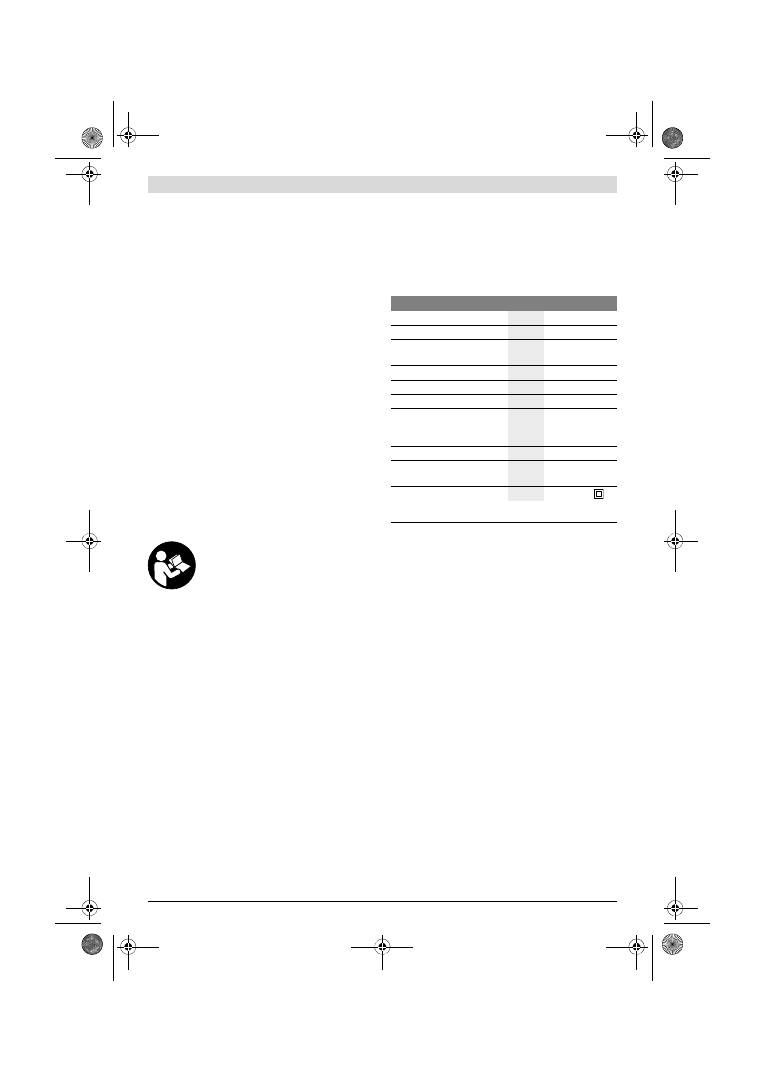
12
| English
2 609 141 028 | (30.1.13)
Bosch Power Tools
When working with the machine, always hold it firmly
with both hands and provide for a secure stance.
The
power tool is guided more secure with both hands.
Secure the workpiece.
A workpiece clamped with clamp-
ing devices or in a vice is held more secure than by hand.
Keep your workplace clean.
Blends of materials are par-
ticularly dangerous. Dust from light alloys can burn or ex-
plode.
Never use the machine with a damaged cable. Do not
touch the damaged cable and pull the mains plug when
the cable is damaged while working.
Damaged cables in-
crease the risk of an electric shock.
Products sold in GB only
: Your product is fitted with an
BS 1363/A approved electric plug with internal fuse (ASTA
approved to BS 1362).
If the plug is not suitable for your socket outlets, it should be
cut off and an appropriate plug fitted in its place by an author-
ised customer service agent. The replacement plug should
have the same fuse rating as the original plug.
The severed plug must be disposed of to avoid a possible
shock hazard and should never be inserted into a mains sock-
et elsewhere.
Products sold in AUS and NZ only
: Use a residual current de-
vice (RCD) with a rated residual current of 30 mA or less.
Product Description and Specifica-
tions
Read all safety warnings and all instruc-
tions.
Failure to follow the warnings and in-
structions may result in electric shock, fire
and/or serious injury.
While reading the operating instructions, unfold the graphics
page for the machine and leave it open.
Intended Use
The machine is intended for dry sanding of wood, plastic, filler
and coated surfaces.
Product Features
The numbering of the product features refers to the illustra-
tion of the machine on the graphics page.
1
Thumbwheel for orbit frequency preselection
2
On/Off switch
3
Lock-on button for On/Off switch
4
Dust box, complete (Microfilter System)
5
Sanding-sheet clamp
6
Sanding plate
7
Sanding sheet
8
Release button for front clamping bracket
9
Front clamping bracket
10
Perforating tool*
11
Screws for sanding plate
12
Extraction outlet
13
Filter element (Microfilter System)
14
Vacuum hose*
*Accessories shown or described are not part of the standard de-
livery scope of the product. A complete overview of accessories
can be found in our accessories program.
Technical Data
Noise/Vibration Information
Measured sound values determined according to EN 60745.
Typically the A-weighted noise levels of the product are:
Sound pressure level 80 dB(A); Sound power level 91 dB(A).
Uncertainty K =3 dB.
Wear hearing protection!
Vibration total values a
h
(triax vector sum) and uncertainty K
determined according to EN 60745:
a
h
=4.5 m/s
2
, K=1.5 m/s
2
.
The vibration emission level given in this information sheet
has been measured in accordance with a standardised test
given in EN 60745 and may be used to compare one tool with
another. It may be used for a preliminary assessment of expo-
sure.
The declared vibration emission level represents the main ap-
plications of the tool. However if the tool is used for different
applications, with different accessories or poorly maintained,
the vibration emission may differ. This may significantly in-
crease the exposure level over the total working period.
An estimation of the level of exposure to vibration should also
take into account the times when the tool is switched off or
when it is running but not actually doing the job. This may sig-
nificantly reduce the exposure level over the total working pe-
riod.
Identify additional safety measures to protect the operator
from the effects of vibration such as: maintain the tool and the
accessories, keep hands warm, organise work patterns.
Orbital sander
GSS 23 AE
Article number
3 601 K70 7..
Rated power input
W
190
Preselection of orbital stroke
rate
No-load speed
min
-1
7000 – 12000
No-load orbital stroke rate
min
-1
14000 – 24000
Orbit diameter
mm
2.0
Sanding sheet dimensions
— Adhesion via Velcro backing
— Attachment via clamping
mm
mm
93 x 185
93 x 230
Sanding plate dimensions
mm
92 x 182
Weight according to
EPTA-Procedure 01/2003
kg
1.7
Protection class
/
II
The values given are valid for a nominal voltage [U] of 230 V. For differ-
ent voltages and models for specific countries, these values can vary.
OBJ_BUCH-80-003.book Page 12 Wednesday, January 30, 2013 9:13 AM
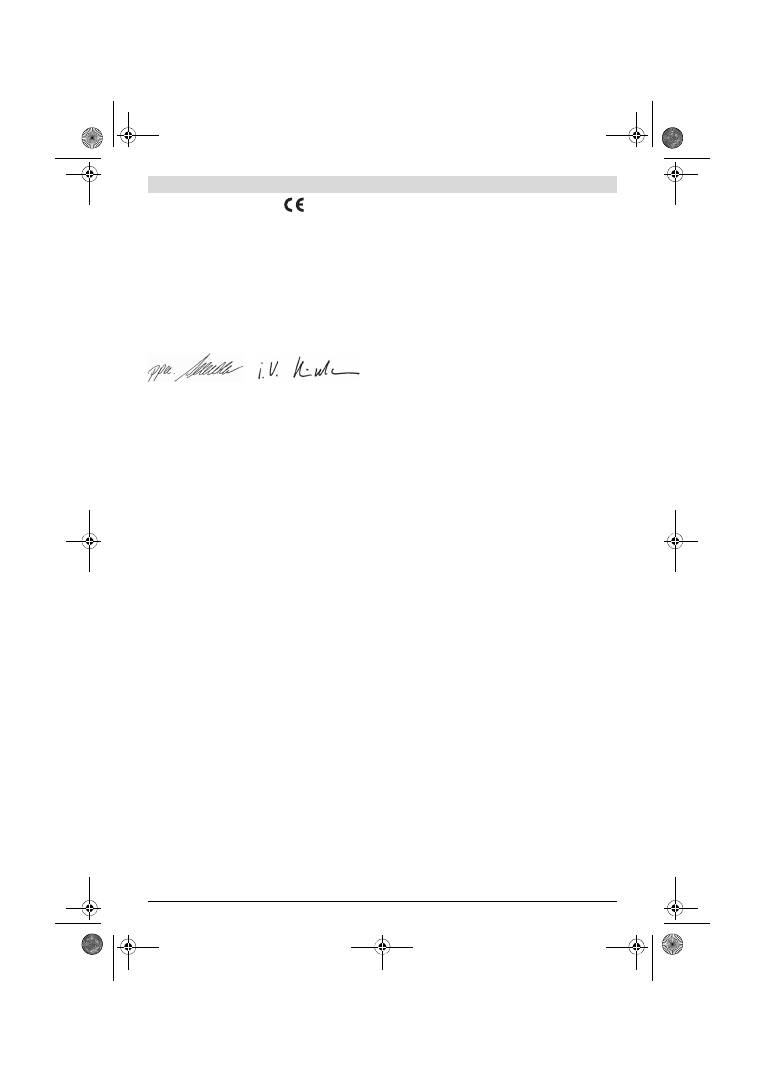
English |
13
Bosch Power Tools
2 609 141 028 | (30.1.13)
Declaration of Conformity
We declare under our sole responsibility that the product de-
scribed under “Technical Data” is in conformity with the fol-
lowing standards or standardization documents: EN 60745
according to the provisions of the directives 2011/65/EU,
2004/108/EC, 2006/42/EC.
Technical file (2006/42/EC) at:
Robert Bosch GmbH, PT/ETM9,
D-70745 Leinfelden-Echterdingen
Robert Bosch GmbH, Power Tools Division
D-70745 Leinfelden-Echterdingen
07.11.2007
Assembly
Before any work on the machine itself, pull the mains
plug.
Dust/Chip Extraction
Dusts from materials such as lead-containing coatings,
some wood types, minerals and metal can be harmful to
one’s health. Touching or breathing-in the dusts can cause
allergic reactions and/or lead to respiratory infections of
the user or bystanders.
Certain dusts, such as oak or beech dust, are considered
as carcinogenic, especially in connection with wood-treat-
ment additives (chromate, wood preservative). Materials
containing asbestos may only be worked by specialists.
– As far as possible, use a dust extraction system suita-
ble for the material.
– Provide for good ventilation of the working place.
– It is recommended to wear a P2 filter-class respirator.
Observe the relevant regulations in your country for the
materials to be worked.
Integrated Dust Extraction with Dust Box
(see figures G1
–
G4)
Attach the dust box
4
onto the extraction outlet
12
until it
latches.
To empty the dust box
4
, pull off the dust box downward.
Before opening the dust box
4
, it is recommended to loosen
the dust from the filter element by gently striking it against a
firm support (as shown in the figure).
Grasp the dust box
4
by the recessed grip, fold the filter ele-
ment
13
upward and empty the dust box. Clean the thin
plates of the filter element
13
with a soft brush.
External Dust Extraction (see figure H)
Mount a vacuum hose
14
onto the extraction outlet
12
. Con-
nect the vacuum hose
14
with a vacuum cleaner. An overview
for the connection of various vacuum cleaners can be found at
the end of these instructions.
The vacuum cleaner must be suitable for the material being
worked.
When vacuuming dry dust that is especially detrimental to
health or carcinogenic, use a special vacuum cleaner.
Replacing the Sanding Sheet
When attaching a new sanding sheet, remove any dust or de-
bris from the sanding plate
6
(e. g. with a brush).
To ensure optimum dust extraction, pay attention that the
punched holes in the sanding sheet match with the holes in
the sanding plate.
Sanding Sheets with Velcro Backing (see figure A)
The sanding plate
6
is fitted with Velcro backing for quick and
easy fastening of sanding sheets with Velcro adhesion.
Before attaching the sanding sheet
7
, free the Velcro backing
of the sanding plate
6
from any debris by tapping against it in
order to enable optimum adhesion.
Position the sanding sheet
7
flush alongside one edge of the
sanding plate
6
, then lay the sanding sheet onto the sanding
plate and press firmly.
To remove the sanding sheet
7
, grasp it at one of the tips and
pull it off from the sanding plate
6
.
Sanding Sheets without Velcro Backing (see figures B–D)
Press the release button
8
and keep it depressed.
Guide the sanding sheet
7
to the stop under the opened
front clamping bracket
9
and let go of the release button
8
again. Pay attention that the sanding sheet is clamped
centrally.
Press the sanding sheet clamp
5
inward and pivot it to
the stop.
Fold the sanding sheet
7
firmly around the sanding plate.
Guide the other end of the sanding sheet
7
between the
rear clamping bracket and the red roller on the clamping
bracket
5
.
Hold the sanding sheet tensely and press the clamping
bracket
5
toward the sanding plate to lock the sanding
sheet.
Sanding sheets without holes, e. g. from rolls or by the meter,
can be punctured with the perforating tool
10
for use with
dust extraction. For this, press the machine with the mounted
sanding sheet onto the perforating tool (see figure E).
To remove the sanding sheet
7
, loosen the clamping
bracket
5
and pull out the sanding sheet from the rear holding
fixture. Press the release button
8
and completely remove the
sanding sheet.
Dr. Egbert Schneider
Senior Vice President
Engineering
Helmut Heinzelmann
Head of Product Certification
PT/ETM9
OBJ_BUCH-80-003.book Page 13 Wednesday, January 30, 2013 9:13 AM
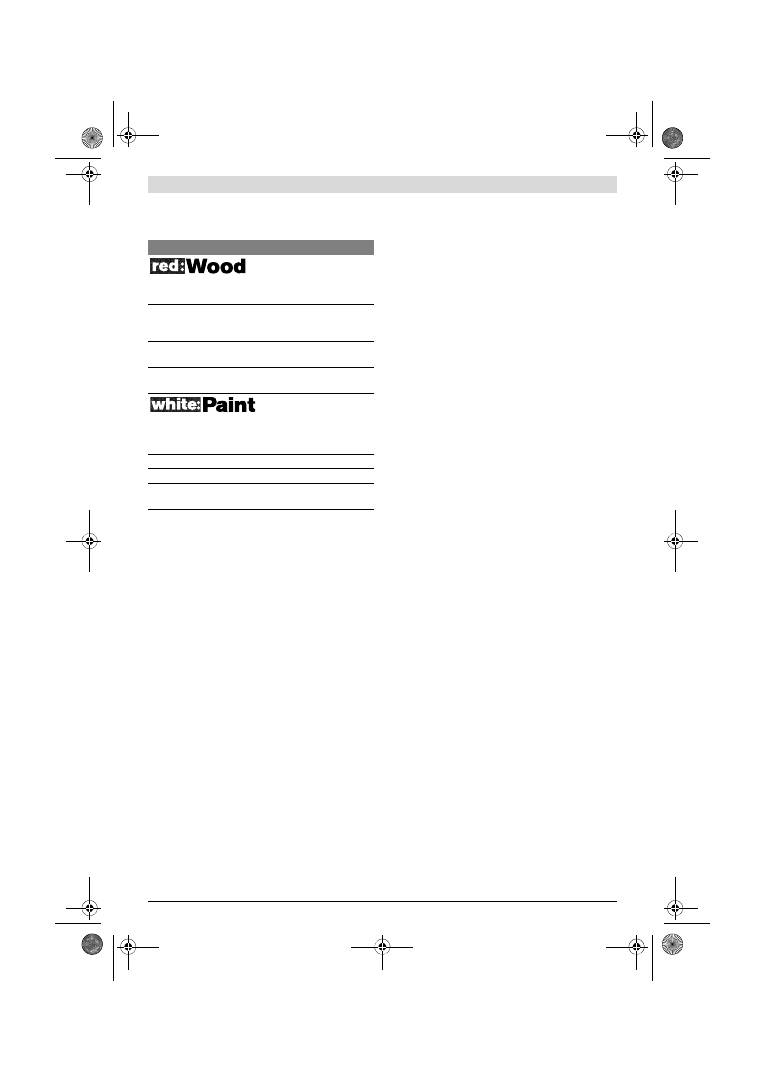
14
| English
2 609 141 028 | (30.1.13)
Bosch Power Tools
Selecting the Sanding Sheet
Depending on the material to be worked and the required rate
of material removal, different sanding sheets are available:
Replacing the Sanding Plate (see figure F)
The sanding plate
6
can be replaced, if required.
Unscrew the 4 screws
11
completely and remove the sanding
plate
6
. Attach the new sanding plate
6
and tighten the screws
again.
Operation
Starting Operation
Observe correct mains voltage! The voltage of the pow-
er source must agree with the voltage specified on the
nameplate of the machine. Power tools marked with
230 V can also be operated with 220 V.
Switching On and Off
To
start
the machine, press the On/Off switch
2
and keep it
pressed.
To lock the
pressed
On/Off switch
2
, press the lock-on button
3
.
To
switch off
the machine, release the On/Off switch
2
or
when it is locked with the lock-on button
3
, briefly press the
On/Off switch
2
and then release it.
To save energy, only switch the power tool on when using it.
Preselecting the Orbital Stroke Rate
With the thumbwheel for preselection of the orbital stroke
rate
1
, you can preselect the required orbital stroke rate, even
during operation.
The required stroke rate depends on the material and the
working conditions and can be determined through practical
testing.
Working Advice
Wait until the machine has come to a standstill before
placing it down.
The removal capacity during sanding is mainly determined by
the selection of the sanding sheet as well as the preselected
orbital stroke rate.
Only flawless sanding sheets achieve good sanding capacity
and extend the service life of the machine.
Pay attention to apply uniform sanding pressure; this increas-
es the working life of the sanding sheets.
Intensifiying the sanding pressure does not lead to an in-
crease of the sanding capacity, but to increased wear of the
machine and the sanding sheet.
A sanding sheet that has been used for metal should not be
used for other materials.
Use only original Bosch sanding accessories.
Maintenance and Service
Maintenance and Cleaning
Before any work on the machine itself, pull the mains
plug.
For safe and proper working, always keep the machine
and ventilation slots clean.
If the replacement of the supply cord is necessary, this has to
be done by Bosch or an authorized Bosch service agent in or-
der to avoid a safety hazard.
If the machine should fail despite the care taken in manufac-
turing and testing procedures, repair should be carried out by
an after-sales service centre for Bosch power tools.
In all correspondence and spare parts order, please always in-
clude the 10-digit article number given on the type plate of
the machine.
After-sales Service and Application Service
Our after-sales service responds to your questions concern-
ing maintenance and repair of your product as well as spare
parts. Exploded views and information on spare parts can al-
so be found under:
www.bosch-pt.com
Bosch’s application service team will gladly answer questions
concerning our products and their accessories.
Great Britain
Robert Bosch Ltd. (B.S.C.)
P.O. Box 98
Broadwater Park
North Orbital Road
Denham
Uxbridge
UB 9 5HJ
Tel. Service: (0844) 7360109
Fax: (0844) 7360146
E-Mail: boschservicecentre@bosch.com
Grain size
For the working of all wooden
materials
40—240
For coarse-sanding, e. g. of
rough, unplaned beams and
boards
coarse
40, 60
For face sanding and planing
small irregularities
medium 80, 100, 120
For finish and fine sanding of
hard woods
fine
180, 240
For the working of
paint/enamel coats or primers
and fillers
40—320
For sanding off paint
coarse
40, 60
For sanding primer
medium 80, 100, 120
For final sanding of primers
before coating
fine
180, 240, 320
OBJ_BUCH-80-003.book Page 14 Wednesday, January 30, 2013 9:13 AM

